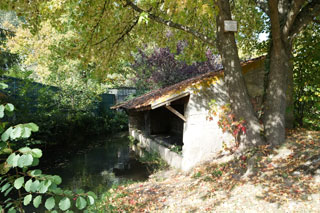Prochain point :
Table de lecture des paysages
Prochain point : lat="49.095600" lon="1.943044"

THE WATER SYSTEM
The Viosne and its sources
The lavoirs…
Around 29 km long, the source of the Viosne is located in the towns of Lierville and Lavilletertre, in the Oise region. Several hydraulic installations have been established along its banks over time. Several
lavoirs (wash houses), both private and communal, were built between 1875 and 1899. Built in 1895, this communal lavoir is an example of traditional architecture with a mono-pitched roof.
In order to supply all the hamlets with water and ensure a strong enough water flow, water from the “Marie Fontaine” water source in the
Orémus Valley, was directed to the reservoir at the intersection of the Santeuil and the Dampont roads. After being distributed to the hamlet of Dampont, the water was pumped with hydraulic rams to the current-day water tower.
...and the mills
With an average flow of 527 litres per second, the Viosne once had as many as 21 mills on its banks between Chars and Pontoise. Three of these flour mills were located in Us: two in the heart of the village (the
Vieux Moulin, or old mill and the
Moulin Neuf, or new mill) and in one in the hamlet of Dampont. When rolling machines replaced millstones, the productivity of certain mills increased significantly. This was the beginning of industrial flour milling. Many small four mills closed over the period around the turn of the 20th century. The mills of Us stopped milling flour and began other activities. The
Vieux Moulin, for example, was transformed into a woodcutting mill from 1900 to 1920.



